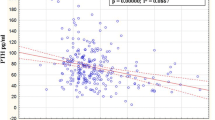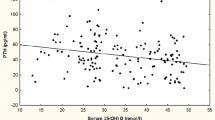Abstract
There is controversial information about the impact of vitamin A on bone. Some epidemiological studies show that excessive intake of vitamin A, or an excess of serum vitamin A, has related with adverse impact on bone mass; however, other studies did not find these links, and some authors have proposed that this vitamin might promote a better bone health. The present work aims to contribute to clarify the real role of vitamin A in bone tissue. For this purpose, a cross-sectional study of 154 osteoporotic non-treated postmenopausal women (> 65 years old) was carried out. Bone mineral density (BMD) was measured by dual-energy X-ray absorptiometry. We assessed concentrations of serum retinol, osteocalcin, parathyroid hormone, alkaline phosphatase, calcium, and phosphorus. We also studied demographic and anthropometric parameters. Spearman’s correlations between retinol levels and other variables found negative correlations with BMD in both lumbar spine (R = − 0.162, P < 0.01) and femoral neck (R = − 0.182, P < 0.01), as well as alkaline phosphatase (R = − 0.110; P < 0.05) and phosphorus (R = − 0.110; P < 0.05). A positive correlation between retinol and fertile window was observed (R = 0.158; P < 0.01). After multivariable adjustment, we still found a negative correlation between serum retinol and BMD, both at the lumbar spine (R = − 0.210; P < 0.01) and at the femoral neck (R = − 0.324, P < 0.001). It is concluded that elevated serum-retinol levels are associated with an increased risk of low bone mass and thus with osteoporotic fractures. Therefore, osteoporosis-risk assessment should include quantification of serum metabolite of vitamin A.

Similar content being viewed by others
Abbreviations
- WHO:
-
World Health Organization
- BMD:
-
Bone mineral density
- DEXA:
-
Dual-energy X-ray absorptiometry
- HPLC:
-
High-performance liquid chromatography
- BMI:
-
Body mass index
- RDA:
-
Recommended dietary allowances
- FNB:
-
Food and nutrition board
- RXR:
-
Nuclear transcription factor
- VDR:
-
Vitamin D receptor
- RAR:
-
Retinoic acid receptor
References
Cashman KD (2007) Diet, nutrition, and bone health. J Nutr 137(11 Suppl):2507S–2512S
Harrison EH (2012) Mechanisms involved in the intestinal absorption of dietary vitamin A and provitamin A carotenoids. Biochim Biophys Acta 1821:70–77
Granado F, Blázquez S, Olmedilla B (2007) Changes in carotenoid intake from fruit and vegetables in the Spanish population over the period 1964–2004. Public Health Nutr 10:1018–1023
Conaway HH, Henning P, Lerner UH (2013) Vitamin A metabolism, action, and role in skeletal homeostasis. Endocr Rev 34:766–797
Melhus H, Michaëlsson K, Kindmark A, Bergström R, Holmberg L, Mallmin H et al (1998) Excessive dietary intake of vitamin A is associated with reduced bone mineral density and increased risk for hip fracture. Ann Intern Med 129:770–778
Michaelsson K, Lithell H, Vessby B, Melhus H (2003) Serum retinol levels and the risk of fracture. N Engl J Med 348:287–294
Feskanich D, Singh V, Willett WC, Colditz GA (2002) Vitamin A intake and hip fractures among postmenopausal women. JAMA 287:47–54
Promislow JHE, Goodman-Gruen D, Slymen DJ, Barrett-Connor E (2002) Retinol intake and bone mineral density in the elderly: the Rancho-Bernardo Study. J Bone Miner Res 17:1349–1358
Opotowsky AR, Bilezikian JP (2004) Serum vitamin A concentration and the risk of hip fracture among women 50 to 74 years old in the United States: a prospective analysis of the NHANES I follow-up study. Am J Med 117:169–174
Lim LS, Harnack LJ, Lazovich D, Folsom AR (2004) Vitamin A intake and the risk of hip fracture in postmenopausal women: the Iowa Women’s Health Study. Osteoporos Int 15:552–559
Macdonald HM, New SA, Golden MH, Campbell MK, Reid DM (2004) Nutritional associations with bone loss during the menopausal transition: evidence of a beneficial effect of calcium, alcohol, and fruit and vegetable nutrients and of a detrimental effect of fatty acids. Am J Clin Nutr 79:155–165
Penniston KL, Weng N, Binkley N, Tanumihardjo SA (2006) Serum retinyl esters are not elevated in postmenopausal women with and without osteoporosis whose preformed vitamin A intakes are high. Am J Clin Nutr 84:1350–1356
Wolf RL, Cauley JA, Pettinger M, Jackson R, Lacroix A, Leboff MS et al (2005) Lack of a relation between vitamin and mineral antioxidants and bone mineral density: results from the women’s health initiative. Am J Clin Nutr 82:581–588
Kaptoge S, Welch A, McTaggart A, Mulligan A, Dalzell N, Day NE et al (2003) Effects of dietary nutrients and food groups on bone loss from the proximal femur in men and women in the 7th and 8th decades of age. Osteoporos Int 14:418–428
Sowers MF, Wallace RB (1990) Retinol, supplemental vitamin A and bone status. J Clin Epidemiol 43: 693–699
Kawahara TN, Krueger DC, Engelke JA, Harke JM, Binkley NC (2002) Short-term vitamin A supplementation does not affect bone turnover in men. J Nutr 132:1169–1172
Rejnmark L, Vestergaard P, Charles P, Hermann AP, Brot C, Eiken P, Mosekilde L (2004) No effect of vitamin A intake on bone mineral density and fracture risk in perimenopausal women. Osteoporos Int 15:872–880
Ballew C, Galuska D, Gillespie C (2001) High serum retinyl esters are not associated with reduced bone mineral density in the Third National Health and Nutrition Examination Survey, 1988–1994. J Bone Miner Res 16:2306–2312
Vestergaard P, Rejnmark L, Mosekilde L (2010) High-dose treatment with vitamin A analogues and risk of fractures. Arch Dermatol 146:478–482
Barker ME, McCloskey E, Saha S, Gossiel F, Charlesworth D, Powers HJ, Blumsohn A (2005) Serum retinoids and β-carotene as predictors of hip and other fractures in elderly women. J Bone Miner Res 20:913–920
Maggio D, Barabani M, Pierandrei M, Polidori MC, Catani M, Mecocci P et al (2003) Marked decrease in plasma antioxidants in aged osteoporotic women: results of a cross-sectional study. J Clin Endocrinol Metab 88:1523–1527
Maggio D, Polidori MC, Barabani M, Tufi A, Ruggiero C, Cecchetti R, Aisa MC, Stahl W, Cherubini A (2006) Low levels of carotenoids and retinol in involutional osteoporosis. Bone 38:244–248
Jackson HA, Sheehan AH (2005) Effect of vitamin A on fracture risk. Ann Pharmacother 39:2086–2090
Wu AM, Huang CQ, Lin ZK, Tian NF, Ni WF, Wang XY, Xu HZ, Chi YL (2014) The relationship between vitamin a and risk of fracture: meta-analysis of prospective studies. J Bone Miner Res 29:2032–2039
Diaz Curiel M, Carrasco de la Peña JL, Honorato Perez J, Perez Cano R, Rapado A, Ruiz Martinez I (1997) Study of BMD in lumbar spine and femoral neck in a Spanish population. Multicentre Research Project on Osteoporosis. Osteoporos Int 7:59–64
Mata-Granados JM, Quesada Gómez JM, Luque de Castro MD (2009) Fully automatic method for the determination of fat soluble vitamins and vitamin D metabolites in serum. Clin Chim Acta 403:126–130
Camacho PM, Lopez NA (2008) Use of biochemical markers of bone turnover in the management of postmenopausal osteoporosis. Clin Chem Lab Med 46:1345–1357
Vasikaran S, Cooper C, Eastell R, Griesmacher A, Morris HA, Trenti T, Kanis JA (2011) International Osteoporosis Foundation and International Federation of Clinical Chemistry and Laboratory Medicine position on bone marker standards in osteoporosis. Clin Chem Lab Med 49:1271–1274
Mata-Granados JM, Luque de Castro MD, Quesada Gómez JM (2008) Inappropriate serum levels of retinol, alpha-tocopherol, 25 hydroxyvitamin D3 and 24,25 dihydroxyvitamin D3 levels in healthy Spanish adults: simultaneous assessment by HPLC. Clin Biochem 41:676–680
Olmedilla B, Granado F, Southon S, Wright AJA, Blanco I, Gil-Martinez E (2001) Serum concentrations of carotenoids and vitamins A, E, and C in control subjects from five European countries. Br J Nutr 85:227–238
Úbeda N, Basagoiti M, Alonso-Aperte E, Varela-Moreiras G (2007) Dietary food habits, nutritional status and lifestyle in menopausal women in Spain. Nutr Hosp 22:313–321
Trumbo P, Yates AA, Schlicker S, Poos M (2001) Dietary reference intakes: vitamin A, vitamin K, arsenic, boron, chromium, copper, iodine, iron, manganese, molybdenum, nickel, silicon, vanadium, and zinc. J Am Diet Assoc 101:294–301
Wang XD, Tang GW, Fox JG, Krinsky NI, Russell RM (1991) Enzymatic conversion of beta-carotene into beta-apo-carotenals and retinoids by human, monkey, ferret, and rat tissues. Arch Biochem Biophys 285:8–16
Scheven BA, Hamilton NJ (1990) Retinoic acid and 1,25-dihydroxyvitamin D3 stimulate osteoclast formation by different mechanisms. Bone 11:53–59
Togari A, Kondo M, Arai M, Matsumoto S (1991) Effects of retinoic acid on bone formation and resorption in cultured mouse calvaria. Gen Pharmacol 22:287–292
Lind T, Sundqvist A, Hu L, Pejler G, Andersson G, Jacobson A, Melhus H (2013) Vitamin A is a negative regulator of osteoblast mineralization. PLoS One 8(12):e82388
Lind T, Öhman C, Calounova G, Rasmusson A, Andersson G, Pejler G, Melhus H (2017) Excessive dietary intake of vitamin A reduces skull bone thickness in mice. PLoS ONE 12(4):e0176217
Caire-Juvera G, Ritenbaugh C, Wactawski-Wende J, Snetselaar LG, Chen Z (2009) Vitamin A and retinol intakes and the risk of fractures among participants of the Women’s Health Initiative Observational Study. Am J Clin Nutr 89:323–330
Tanumihardjo SA (2013) Vitamin A and bone health: the balancing act. J Clin Densitom 16:414–419
Mata-Granados JM, Cuenca-Acevedo R, Luque de Castro MD, Sosa M, Quesada-Gómez JM (2010) Vitamin D deficiency and high serum levels of vitamin A increase the risk of osteoporosis evaluated by quantitative ultrasound measurements (QUS) in postmenopausal Spanish women. Clin Biochem 43:1064–1068
Mata-Granados JM, Cuenca-Acevedo JR, Luque de Castro MD, Holick MF, Quesada-Gómez JM (2013) Vitamin D insufficiency together with high serum levels of vitamin A increases the risk for osteoporosis in postmenopausal women. Arch Osteoporos 8:124
de Jonge EA, Kiefte-de Jong JC, Campos-Obando N, Booij L, Franco OH, Hofman A, Uitterlinden AG, Rivadeneira F, Zillikens MC (2015) Dietary vitamin A intake and bone health in the elderly: the Rotterdam Study. Eur J Clin Nutr 69:1360–1368
Joo NS, Yang SW, Song BC, Yeum KJ (2015) Vitamin A intake, serum vitamin D and bone mineral density: analysis of the Korea National Health and Nutrition Examination Survey (KNHANES, 2008–2011). Nutrients 7:1716–1727
Furr HC, Amedee-Manesme O, Clifford AJ, Bergen HR 3rd, Jones AD, Anderson DP et al (1989) Vitamin A concentrations in liver determined by isotope dilution assay with tetradeuterated vitamin A and by biopsy in generally healthy adult humans. Am J Clin Nutr 49:713–716
Acknowledgements
The authors are indebted to all participants and the staff of the “Maimonides Biomedical Research Institute of Cordoba” (IMIBIC) for their dedicated and conscientious collaboration and assistance. Also, we are grateful to the Thematic Network of Corporative Research in Aging and Frailty (RETICEF) and CIBERFES for its scientific aid.
Funding
P06-FQM-01515 Excellence Project from “Consejería de Innovación, Ciencia y Empresa,” “Junta de Andalucía,” CM0010/05 FIS Project from “Instituto de Salud Carlos III,” SAF2005-05254 Project from “Ministerio de Educación y Cultura,” PAIDI group CTS-413 and PAIDI group FQM-227 of “Junta de Andalucía” (Spain). RETICEF & CIBERFES, “Instituto de Salud Carlos III.”
Author information
Authors and Affiliations
Corresponding author
Ethics declarations
Conflict of interest
The authors declare that the research was conducted in the absence of any commercial or financial relationships that could be considered as a potential conflict of interest.
Human and Animal Rights and Informed Consent
The study was approved by the regional ‘CEIC’ (Clinical Research Ethics Committee) of Córdoba due to Reina Sofía Univertity of Córdoba was the coordinating center. Other hospitals participating in the study, according to the regulations, subsequently adhered after get the permission from their respective Clinical Research Ethics Committees. They guarantee the clinical research is performed in accordance with the ethical standards as laid down in the 1964 Declaration of Helsinki and its later amendments or comparable ethical standards. Informed consent was obtained from all individual participants included in the study.
Rights and permissions
About this article
Cite this article
Navarro-Valverde, C., Caballero-Villarraso, J., Mata-Granados, J.M. et al. High Serum Retinol as a Relevant Contributor to Low Bone Mineral Density in Postmenopausal Osteoporotic Women. Calcif Tissue Int 102, 651–656 (2018). https://doi.org/10.1007/s00223-017-0379-8
Received:
Accepted:
Published:
Issue Date:
DOI: https://doi.org/10.1007/s00223-017-0379-8




